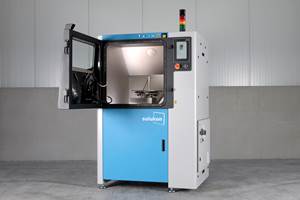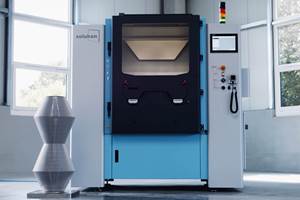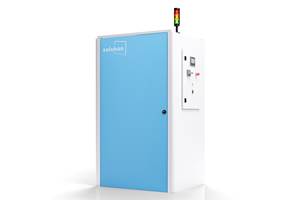Enhanced Digital Factory Tool Quantifies Carbon Footprint of Automated Depowdering
Solukon has enhanced its Digital Factory Tool, which integrates additive manufacturing automation and quality assurance, giving the sensor and interface kit a more comprehensive transparency in automated depowdering.
Share
Read Next
Solukon has enhanced its sensor and interface kit — Digital Factory Tool (DFT) — to measure the energy consumption and CO2 emissions of industrial depowdering. The company says the DFT is a one-of-a-kind tool for comprehensive transparency in automated depowdering. With the DFT enhancements, Solukon says it has acted in anticipation of future legal regulations on measuring CO2 emissions in machine manufacturing.
In addition to manufacturing depowdering systems, Solukon also takes into account comprehensive quality monitoring and the digital integration of the machines. The DFT handles those aspects, working as a smart sensor and interface kit for process validation, quality control and automation integration. It also records all relevant depowdering process data and summarizes the values in a protocol file. Critical limit values can be set for relevant data so that deviations can be directly displayed and assessed. All data collected with the tool can be compiled via OPC UA and then integrated into the control center's digital dashboards.
Customer feedback has been integrated directly into the tool upgrade, in which Solukon aims to boost data transparency to a higher level. “Our concept of full transparency does not stop at the performance values of the depowdering process,” says Andreas Hartmann, Solukon CEO/CTO. “It was important to us to quantify the carbon footprint of automated depowdering.”
The DFT upgrade is in anticipation of future legal regulations. For example, the U.S. Securities and Exchange Commission (SEC) and the Corporate Sustainability Report Directive of the European Union both stipulate that (publicly traded) companies must disclose their environmental behavior in an annual report or sustainability report as of 2024 or 2025. According to the SEC, emissions that machines generate when they are in use in the respective company are considered CO2 emissions, which of course includes the emissions generated by automated depowdering.
With the enhanced DFT, Solukon measures the consumption of the following resources and the proportion of manual labor:
- Compressed Air Consumption — Solukon makes the compressed air consumption per cleaning step transparent with a compressed air counter.
- Power Consumption — Effective immediately, users can gain insight into the kilowatt hours of electricity expended per cleaning cycle and since commissioning the Solukon system. Expended kilowatt hours of electricity are a key value for measuring the next, highly relevant value.
- Carbon footprint — The main upgrade in the enhanced DFT is that the carbon footprint of depowdering is now measurable. From their energy supplier, Solukon customers find out the value for the CO2 consumption per kilowatt hour of electricity. There is a variable input field in the upgraded DFT for this carbon factor of electricity, as well as the carbon factor of compressed air consumption. With the two values, the DFT calculates the carbon footprint of the depowdering process.
- Time Recording For Manual Intervention/Finishing — With the upgrade, it is possible to track the time during which the flap for manual depowdering and finishing via compressed air gun was open. This makes the proportion of manual process steps clearly and immediately quantifiable.
The Digital Factory Tool with advanced features is compatiblewith Solukon's SFM-AT350/-E, SFM-AT800-S and SFM-AT1000-S systems.
- Learn more about the Solukon Digital Factory Tool which integrates AM automation and quality assurance. The system is designed to increase efficiency and ensure continuous quality control in additive manufacturing.
- Read about Solukon upgrading the SFM-AT350 depowdering system for medium-sized parts. System upgrades include the addition of the SPR-Pathfinder depowdering software, a new form of excitation for depowdering delicate structures and new tracking options with the enhanced Digital Factory Tool.
Related Content
Solukon Creates Distribution Partnership with URMA
URMA is working with Solukon on the automated depowdering of metal parts.
Read MoreSolukon Upgrades SFM-AT350 Depowdering System for Medium-Sized Parts
Formnext 2023: System upgrades include the addition of the SPR-Pathfinder depowdering software, a new form of excitation for depowdering delicate structures and new tracking options with the enhanced Digital Factory Tool.
Read MoreLauncher Acquires Solukon Depowdering System for Postprocessing Rocket Parts
The depowdering system removes residual and clogged powder from metal laser-melted parts within a sealed process chamber, using adjustable vibration and automated two-axis part rotation while recovering superfluous powder.
Read MoreSolukon’s Metal Powder Collection Unit Offers Simple, Safe Material Handling
With the SFM-PCU integrated into the additive manufacturing system, users no longer have direct contact with the powder material during depowdering — the powder remains in a closed system at all times.
Read MoreRead Next
Hybrid Additive Manufacturing Machine Tools Continue to Make Gains (Includes Video)
The hybrid machine tool is an idea that continues to advance. Two important developments of recent years expand the possibilities for this platform.
Read More3D Printing Brings Sustainability, Accessibility to Glass Manufacturing
Australian startup Maple Glass Printing has developed a process for extruding glass into artwork, lab implements and architectural elements. Along the way, the company has also found more efficient ways of recycling this material.
Read More4 Ways the Education and Training Challenge Is Different for Additive Manufacturing
The advance of additive manufacturing means we need more professionals educated in AM technology.
Read More











.png;maxWidth=300;quality=90)












